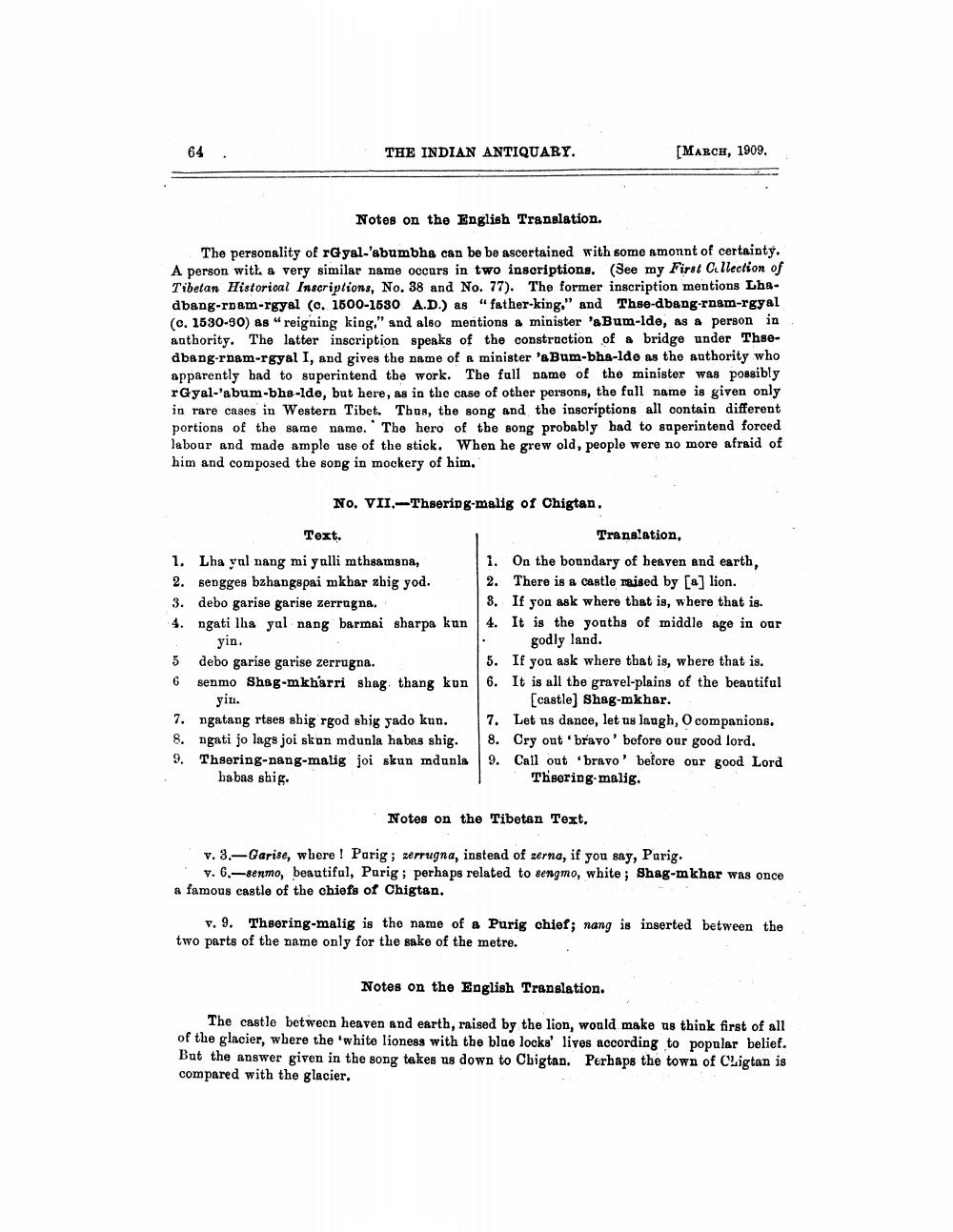________________
64
THE INDIAN ANTIQUARY.
(MARCH, 1909.
Notes on the English Translation.
The personality of rGyal-'abumbha can be be ascertained with some amonnt of certainty. A person with a very similar name occurs in two inscriptione. (See my First C.llection of Tibetan Historical Inscriptions, No. 38 and No. 77). The former inscription mentions Lhadbang-rdam-rgyal (c. 1500-1530 A.D.) as "father-king." and Thse-dbang-rnam-rgyal (c. 1530-90) as "reigning king," and also mentions a minister '&Bum-lde, as a person in authority. The latter inscription speaks of the construction of a bridge ander Thsedbang-rnam-rgyal I, and gives the name of a minister 'Bum-bhs-lde as the authority who apparently had to superintend the work. The full name of the minister was possibly rGyal-'abum-bha-lde, but here, as in the case of other persons, the fall name is given only in rare cases in Western Tibet. Thus, the song and the inscriptions all contain different portions of the same name.' The hero of the song probably had to superintend forced labour and made ample use of the stick. When he grew old, people were no more afraid of him and composed the song in mockery of him.
NO. VII.-Thsering-malig of Chigtan. Text.
Translation, 1. Lha yal nang mi yalli mthsamgna, 1. On the bonndary of heaven and earth, 2. sengges bzhangspai mkhar abig yod. 2. There is a castle raised by [a] lion. 3. debo garise garise zerrugna.
3. If you ask where that is, where that is. 4. ngati lha yal nang barmai sharpa kun 4. It is the youths of middle age in our yin.
1. godly land. 5 debo garise garise zerrugna.
5. If you ask where that is, where that is. 6 senmo Shag-mkharri shag thang kun 6. It is all the gravel-plains of the beautiful yin.
[castle) Shag-mkhar. 7. ngatang rtses shig rgod shig yado kun. 7. Let us dance, let us laugh, 0 companions, 8. ngati jo lags joi skun mdunla habas shig. 8. Cry outbravo'before our good lord. 9. Thsoring-nang-malig joi skun mdunla | 9. Call out bravo' before our good Lord babas shig.
'Theering-malig.
Notes on the Tibetan Text.
v. 3.-Garise, where ! Parig; zerrugna, instead of zerna, if you say, Parig.
y. 6.-Senmo, beautiful, Parig ; perhaps related to sengmo, white; Shag-mkhar was once a famous castle of the chiefs of Chigtan.
v. 9. Thsering-malig is the name of a Purig chief; nang is inserted between the two parts of the name only for the sake of the metre.
Notes on the English Translation.
The castle between heaven and earth, raised by the lion, would make us think first of all of the glacier, where the 'white lioness with the blue locks' lives according to popular belief. But the answer given in the song takes us down to Cbigtan. Perhaps the town of Cligtan is compared with the glacier.




